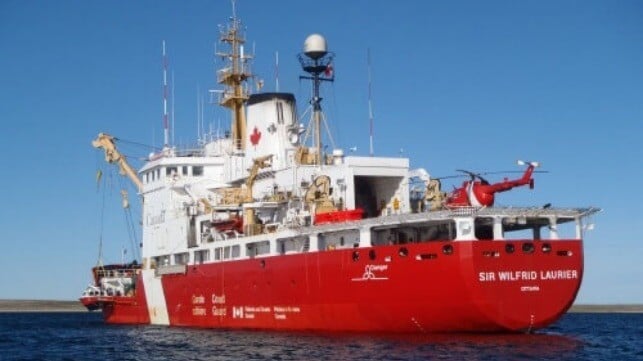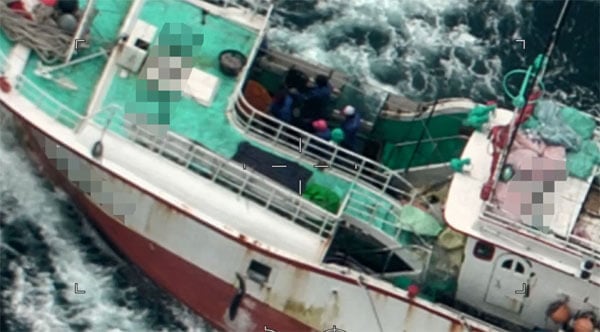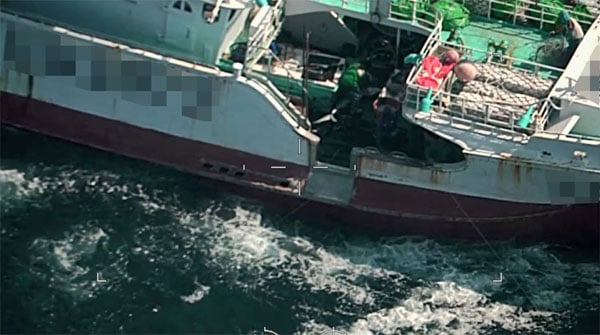North Pacific Patrols Again Document Widespread Illegal Fishing

The waters of the North Pacific continue to be hotspots for illegal, unreported, and unregulated (IUU) fishing, report the U.S. and Canadian Coast Guard at the conclusion of more than two months of patrols. They are reporting the harvesting of shark fins continues unabated, as are criminal activities largely masterminds by dark fleet vessels.
The annual multinational mission known as Operation North Pacific Guard included patrolling the waters both at sea, in the air, as well as through satellite observations. They report it has once again exposed the deeply rooted menace of IUU.
The mission, which is led by Canada and brings together partners including the U.S., Japan, and Korea, saw Canadian fishery officers and crew aboard the multipurpose coast guard ship Sir Wilfrid Laurier patrol over 20,000 kilometers of North Pacific waters. During the mission, they conducted inspections of 15 fishing vessels and found illegally harvested shark fins, evidence of fishing during a closed season, and unreported catch. They also documented instances of marine pollution.

USCG images from 2024 patrol
The officers also discovered that many vessels had their monitoring systems switched off. They reported the vessels were attempting to carry out the criminal activities as dark vessels.
Apart from the sea patrols, Canada also conducted aerial observations flying over 50,000 nautical miles over the course of 34 patrols, and visually inspected 407 vessels. They reportedly discovered additional incidents of shark finning, the targeted harvest of dolphins, pollution incidents, and vessel marking violations.
The U.S. Coast Guard cutter Midgett, which was part of the mission, conducted 21 high-seas boardings and inspections that detected four potential fishery violations under international laws. In the air, the USCG observed 411 vessels and was able to detect potential shark finning violations and improper fishing vessel markings on multiple vessels.?

The mission report highlights that IUU fishing, which is detrimental in the long-term, undermines national security, international relations, and global economics, continues to flourish. Annually, up to 27 million tons of fish are caught illegally worldwide, a demonstration officials said of a vibrant underhand industry that is responsible for depleting fish stocks. The illegal activities also threaten the livelihoods of legitimate fish harvesters around the globe.
“Canada’s ongoing presence in the North Pacific is an example of the multi-national cooperation required to monitor and protect fish stocks and marine ecosystems,” said Diane Lebouthillier, Canada’s Minister of Fisheries, Oceans and the Coast Guard.
Operation North Pacific Guard aims to monitor and enforce the United Nations ban on high seas driftnets and to ensure compliance with regulations that protect against IUU fishing. Fishery officers also collect environmental data and water samples to support the understanding of the high seas environment, including the migration range of species of interest, such as Pacific salmon, and the levels of microplastics in the water.
During this year’s mission, Canadian officers reported they had their first opportunity to enforce the newly adopted ban on Pacific salmon retention, which has been in force for North Pacific fishing fleets since this July.
“IUU fishing is a complex and global problem that calls for an international unified response,” said Capt. Ryan Waters, chief of enforcement for the Coast Guard’s Seventeenth District. “North Pacific Guard is a prime example of a strong, sustained?multi-lateral partnership to maximize the impact of collective counter-IUU fishing enforcement efforts and promote the rule of law at sea.”?
Operation North Pacific Guard is supported by funding from the Pacific Salmon Strategy Initiative, which aims to enhance conservation, protection, and enforcement efforts in high-risk areas for Canada’s Pacific salmon stocks.
